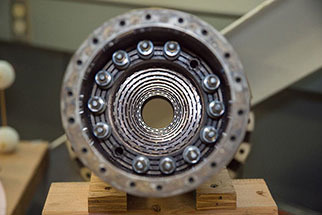
The empty space inside this uninstalled resistive magnet is called the bore: That’s where experiments go.
What is the bore of a magnet? We promise, it's anything but boring.
The research electromagnets at the National MagLab, whether made with bitter plates or with superconductors, are coils that are a few feet long and hollow in the middle. That empty space in the middle of the magnet is called the bore, and that’s where the magnetic field generated by the electricity running through the coil is the strongest. That is also where the scientists put their samples to discover information revealed by those strong fields.
In the magnetic resonance imaging (MRI) machines used in hospitals, those bores are relatively wide: After all, a whole person needs to fit inside! In the research magnets used at the National MagLab, however, bores are typically far smaller — ranging from just 10 to 105 mm (about 0.4 inches to 4 inches) - from smaller than the size of an asprin to about the size of a toilet tissue roll.
When you make the bore bigger, you sacrifice magnetic field strength, and scientists value the strong fields over space. Because space is so tight, the samples used in experiements have to be very small, especially since most of that area is taken up by a probe, a long, fancy stick used to insert the sample into the magnet bore to collect measurements.
Science advisor: Jack Toth


